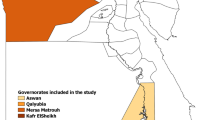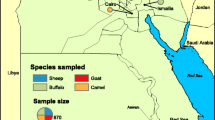Abstract
Rift Valley fever (RVF) is an arthropod-borne viral zoonotic disease that affects a wide range of animals including sheep, goats, cattle, camels and humans. Camels have only recently been introduced into Tanzania and, as a result, there is no credible diseases status information concerning this population, estimated to be in the low hundreds. As part of a broader study on camel diseases in different localities of northern Tanzania, serum samples (n = 109) were collected from apparently healthy, non-vaccinated camels during the period June to August 2010 and tested for antibodies specific to RVF virus (RVFV) using the inhibition enzyme-linked immunosorbent assay (ELISA). Overall, herd and individual camel IgG seroprevalence was 78.5 % (11/14) and 27.5 % (30/109), respectively. IgG was found to be most prevalent in camels from Kilindi and Hai districts (45 %, each) and in introduced camels from other areas (37.1 %). The relationship between age and seropositivity showed that the seroprevalence was the highest (84.6 %) in age group of ≥10 years and lowest (11.9 %) in age group of ≤5 years.
The results of this study reveal that evidence of camels being exposed to RVFV and that the risk of seropositivity varied according to district, being higher in Kilindi and Hai compared with other districts sampled. The risk of seropositivity increased with increasing animal age and the introduction of camels into the herd. Based on these study findings, continuous disease surveillance of camels for RVFV is indicated.
Similar content being viewed by others
Abbreviations
- ELISA:
-
Enzyme-linked immunosorbent assay
- IgG:
-
Immuno globulin G
- OD:
-
Optical density
- PBS:
-
Phosphate-buffered saline
- PI:
-
Percentage inhibition
References
Ahmed, B., El Mamy, O., Baba, M. O., Barry, Y., Isselmou, K., Dia, M. L., Hampate, B., Diallo, M.Y., El Kory, M. O. B., Diop, M., Lo, M. M., Thiongane, Y., Bengoumi, M., Puech, L., Plee, L., Filip Claes, F., de La Rocque, S. and Doumbia, B., 2011. Unexpected Rift Valley Fever Outbreak, Northern Mauritania, Emerging Infectious Diseases, 17(10), 1894- -1896.
Bird, B. H., Githinji, J. W., Macharia, J. M., Kasiiti, J. L., Muriithi, R. M., Gacheru, S. G., Musaa, J. O., Towner, J. S., Reeder, S. A., Oliver, J. B., Stevens, T. L., Erickson, B. R., Morgan, L.T., Khristova, M. L., Hartman, A. L., Comer, J. A., Rollin, P. E., Ksiazek, T. G. and Nichol, S. T,. 2008. Multiple virus lineages sharing recent common ancestry were associated with a Large Rift Valley fever outbreak among livestock in Kenya during 2006-2007, Journal of Virology, 82(22), 11152--11166.
Britch, S. C., Binepal, Y. S., Ruder, M. G., Kariithi, H. M., Linthicum, K. J., Anyamba, A., Jennifer, L., Small, J. L., Tucker, C. J., Leonard, O., Ateya, L. O., Oriko, A. A., Gacheru, S. and Wilson, W. C., 2013. Rift Valley Fever Risk Map Model and Seroprevalence in Selected Wild Ungulates and Camels from Kenya, PLoS One, 8(6), e66626.
Chevalier, V., Pepin, M., Plee, L. and Lancelot, R., 2010. Rift Valley fever - a threat for Europe? Euro Surveillance, 15(10), 19506.
Davies, F. G., Koros, J. and Mbugua, H., 1985. Rift Valley fever in Kenya: the presence of antibodies to the virus in camels (Camelus dromedarius), The Journal of Hygiene 94, 241--244.
Di Nardo, A. D., Rossi, D., Saleh, M. S., Lejlifa, S. M., Hamdi, S. J., Gennaro, A. D., Savini, G. and Thrusfield, M. V., 2014. Evidence of Rift valley fever seroprevalence in the Sahrawi semi-nomadic pastoralist system, Western Sahara, BMC Veterinary Research, 10, 92
DVSAH (Director of Veterinary Science and Animal Husbandry), 1926-1934. Annual Reports of the Department of Veterinary Science and Animal Husbandry, (Government Printer: Dar es Salaam).
El Mamy, A. B., Baba, M. O., Barry, Y., Isselmou, K., Dia, M. L., El Kory, M. O., Diop, M., Lo, M. M., Thiongane, Y., Bengoumi, M., Puech, L., Plee, L., Claes, F., de la Roque, S. and Doumbia, B., 2011. Unexpected Rift Valley fever outbreak, northern Mauritania, Emerging Infectious Diseases, 17(10), 1894- -1896.
Evans, A., Gakuya, F., Paweska, J. T., Rostal, M., Akoolo, L., Van Vuren, P. J., Manyibe, T., Macharia, J. M., Ksiazek, T. G., Feikin, D. R., Breiman, R. F. and Kariuki Njenga, M., 2008. Prevalence of antibodies against Rift Valley fever virus in Kenyan wildlife, Epidemiology and Infection, 136(9), 1261-1269.
Fafetine, J., Neves, L., Thompson, P. N., Paweska, J. T., Rutten, V. P. and Coetzer, J. A., 2013. Serological evidence of Rift Valley fever virus circulation in sheep and goats in Zambézia Province, Mozambique, PLoS Neglected Tropical Diseases, 7(2), e2065.
Hartley, B. J., 1990. The one-humped camel (Camelus dromedarius) in northern Tanzania. Proceeding of Tanzania Society of Animal Production, Arusha, Tanzania, 17, 185--190.
Hassan, O. A., Ahlm, C., Sang, R. and Evander, M., 2011. The 2007 Rift Valley fever outbreak in Sudan, PLoS Neglected Tropical Diseases, 5(9), e1229.
Heinrich, N., Saathoff, E., Weller, N., Clowes, P., Kroidl, I., Ntinginya, E., Machibya, H., Maboko, L., Löscher, T., Dobler, G. and Hoelscher, M., 2012. High seroprevalence of Rift Valley fever and evidence for endemic circulation in Mbeya Region, Tanzania, in a cross-sectional study, PLoS Neglected Tropical Diseases, 6(3), e1557.
Hoogstraal, H., Meegan, J. M., Khalil, G. M. and Adham, F. K., 1979. The Rift Valley fever epizootic in Egypt 1977-78. 2. Ecological and entomological studies, Transactions of the Royal Society of Tropical Medicine and Hygiene, 73(6), 624- -629.
HPI (Heifer project International), 2010. Heifer in the news. Accessed on 16 July, 2014 from Www.heifer.org/site/apps/nlnet/content2.aspx
Jackel, S., Eiden, M., El Mamy, B. O., Isselmou, K., Vina-Rodriguez, A., Doumbia, B. and Groschup, M. H. 2013. Molecular and serological studies on the Rift Valley fever outbreak in Mauritania in 2010, Transboundary and Emerging Diseases, 60 (Suppl. 2), 31- -39.
Jost, C. C., Nzietchueng, S., Kihu, S., Bett, B., Njogu, G., Swai, E. S. and Mariner, J. C., 2010. Epidemiological assessment of the Rift Valley fever outbreak in Kenya and Tanzania in 2006 and 2007, American Journal of Tropical Medicine and Hygiene, 83 (Suppl 2), 65- -72.
Köhler-Rollefson, I., Paul, M. and Evelyn, M., 2001. A field manual of camel diseases. Traditional and modern veterinary care for the dromedary. Published by ITDG Publishing and the League for Pastoral Peoples. pp 254.
LaBeaud, A. D., Cross, P. C., Getz, W. M., Glinka, A. and King, C. H., 2011. Rift Valley fever virus infection in African buffalo (Syncerus caffer) herds in rural South Africa: evidence of inter-epidemic transmission, American Journal of Tropical Medicine and Hygiene, 84, 641–646.
Manore, C. A. and Beechler, B. R., 2013. Inter-Epidemic and between-season persistence of Rift Valley fever: Vertical transmission or Cryptic Cycling? Transboundary and Emerging Diseases, doi: 10.1111/tbed.12082
Mariner, J. C., Morrill, J. and Ksiazek, T. G., 1995. Antibodies to hemorrhagic fever viruses in domestic livestock in Niger: Rift Valley fever and Crimean-Congo hemorrhagic fever, American Journal of Tropical Medicine and Hygiene, 53(3), 217- -221.
Markin, V. A., Pantiukhov, V. B., Markov, V. I. and Bondarev, V. P., 2012. Rift valley fever-review, Zhurnal Mikrobiologii Epidemiologii Immunobiologii, (5), 95- -103.
Olaleye, O. D., Tomori, O. and Schmitz, H., 1996. Rift Valley fever in Nigeria: infections in domestic animals, Revue ScientifiqueTechnique office international des Epizooties, 15(3), 937- -946.
Paweska, J. T., Mortimer, E., Leman, P. A. and Swanepoel, R., 2005. An inhibition enzyme-linked immunosorbent assay for the detection of antibody to Rift Valley fever virus in humans, domestic and wild ruminants, Journal of Virological Methods, 127, 10- -18.
Pelant, R. K., Gudala, D. J., Chandra, B. and Kinney, E., 1997. Camels for socio-economic development in India and Tanzania, Journal of Camel Practice and Research, 6, 119--122.
Pepin, M., Bouloy, M., Bird, B. H., Kemp, A. and Paweska, J., 2010. Rift Valley fever virus (Bunyaviridae: Phlebovirus): an update on pathogenesis, molecular epidemiology, vectors, diagnostics and prevention, Veterinary Research, 41, 61.
Rich, K. M. and Wanyoike, F., 2010. An assessment of the regional and national socio-economic impacts of the 2007 Rift Valley fever outbreak in Kenya, American Journal of Tropical Medicine and Hygiene, 83, 52- -57.
Rostal, M. K., Evans, A. L., Sang, R., Gikundi, S., Wakhule, L., Munyua, P., Macharia, J., Feikin, D. R., Breiman, R. F. and Njenga, M. K., 2010. Identification of potential vectors of and detection of antibodies against Rift Valley fever virus in livestock during inter-epidemic periods, American Journal of Veterinary Research, 71, 522- -526.
Sindato, C., Karimuribo, E. and Mboera, E. G., 2011. The epidemiology and socio-economic impact of Rift Valley fever epidemics in Tanzania: A review, Onderstepoort Journal of Veterinary Research, 79(2), E1.
Sindato, C., Karimuribo, E. D., Pfeiffer, D. U., Mboera, L. E. G., Kivaria, F., Dautu, G., Bernard, B. and Paweska, J. T. 2014. Spatial and temporal pattern of Rift Valley fever outbreaks in Tanzania; 1930 to 2007, PLoS One, 9(2), e88897.
Sumaye, R. D., Geubbels, E., Mbeyela, E. and Berkvens, D., 2013. Inter-epidemic Transmission of Rift Valley fever in livestock in the Kilombero river valley, Tanzania: A cross-sectional survey, PLoS Neglected Tropical Diseases, 7(8), e2356.
Swai, E. S. and Schoonman, L., 2009. Prevalence of Rift Valley Fever immunoglobulin G antibody in various occupational groups before the 2007 outbreak in Tanzania, Vector Borne and Zoonotic Diseases, 9, 579-582.
Swanepoel, R. and Paweska, J. T., 2011. Rift Valley fever. Oxford Textbook of Zoonoses: Biology, Clinical Practise, and Public Health Control, 2nd edition (eds. S. R. Palmer, E. J. L. Soulsby, P. Torgerson and D. Brown), Oxford: Oxford University Press, 688-717.
Tchouassi, D. P., Sang, R., Sole, C. L., Bastos, A. D. S., Teal, P. E., Borgemeister, C. and Torto, B. 2013. Common host-derived chemicals increase catches of disease-transmitting mosquitoes and can improve early warning systems for Rift Valley fever virus, PLoS Neglected Tropical Diseases, 7(1), e2007.
Wilson, R. T. 2011. The one-humped camel and the environment in northern Tanzania, Journal of Camel Practice and Research, 18 (1), 25--29.
Acknowledgments
We would like to thank camel owners for their invaluable collaboration during the collection of the data and samples. We thank the district veterinary authorities, Heifer Project International for providing the initial data on camels. We thank Dr. C. Daborn from TVS for critical review and language appraisal of late draft of this manuscript. The staff at VIC and FVM-SUA are thanked for their field and laboratory support. The director of veterinary services is also acknowledged for the permission to publish this paper. The study was co-funded by DVS-MoLDF, Dar-es-Salaam, Tanzania, and Wellcome Trust Grant WT087546MA to the Southern African Centre for Infectious Disease Surveillance, for which we are grateful.
Conflict of interest
None of the authors of this paper has a financial or personal relationship with other people or organization that could inappropriately influence or bias the content of the paper.
Author information
Authors and Affiliations
Corresponding author
Rights and permissions
About this article
Cite this article
Swai, E.S., Sindato, C. Seroprevalence of Rift Valley fever virus infection in camels (dromedaries) in northern Tanzania. Trop Anim Health Prod 47, 347–352 (2015). https://doi.org/10.1007/s11250-014-0726-y
Received:
Accepted:
Published:
Issue Date:
DOI: https://doi.org/10.1007/s11250-014-0726-y




